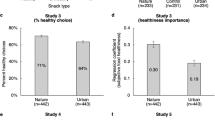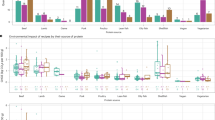Abstract
Objective and purpose:
Although there is increasing interest in how environmental factors influence food intake, there are mixed results and misunderstandings of how proximity and visibility influence consumption volume and contribute to obesity. The objective of this paper is to examine two questions: first, how does the proximity and salience of a food influence consumption volume? Second, are proximate foods consumed more frequently because they are proximate, or are they consumed more frequently because people lose track of how much they eat?
Research methods and procedures:
The 4-week study involved the chocolate candy consumption of 40 adult secretaries. The study utilized a 2 × 2 within-subject design where candy proximity was crossed with visibility. Proximity was manipulated by placing the chocolates on the desk of the participant or 2 m from the desk. Visibility was manipulated by placing the chocolates in covered bowls that were either clear or opaque. Chocolates were replenished each evening, and placement conditions were rotated every Monday. Daily consumption was noted and follow-up questionnaires were distributed and analyzed.
Results:
There were main effects for both proximity and visibility. People ate an average of 2.2 more candies each day when they were visible, and 1.8 candies more when they were proximately placed on their desk vs 2 m away. It is important to note, however, that there was a significant tendency for participants to consistently underestimate their daily consumption of proximately placed candies (−0.9) and overestimate their daily consumption of less proximately placed candies (+0.5).
Discussion:
These results show that the proximity and visibility of a food can consistently increase an adult's consumption of it. In addition, these results suggest that people may be biased to overestimate the consumption of foods that are less proximate, and to underestimate those that are more proximate. Knowing about these deviation tendencies is important for those attempting effectively monitor their consumption of fat and sugar.
This is a preview of subscription content, access via your institution
Access options
Subscribe to this journal
Receive 12 print issues and online access
$259.00 per year
only $21.58 per issue
Buy this article
- Purchase on Springer Link
- Instant access to full article PDF
Prices may be subject to local taxes which are calculated during checkout

Similar content being viewed by others
References
Thomas PR . Improving America's Diet and Health: From Recommendations to Action. National Academy Press: Washington, DC, 1991.
Glanz K, Basil M, Maibach E, Goldberg J, Snyder D . Why Americans eat what they do: taste, nutrition, cost, convenience, and weight control concerns as influences on food consumption. J Am Diet Assoc 1998; 98: 1118–1126.
Sporny LA, Contento IR . Stages of change in dietary fat reduction social psychological correlates. J Nutr Educ 1995; 27: 191–199.
Gould SJ . An interpretive study of purposeful, mood self regulating consumption: the consumption and mood framework. Psychol Marketing 1997; 14: 395–426.
Patel KA, Schlundt DG . Impact of moods and social context on eating behavior. Appetite 2001; 36: 111–118.
Oliver G, Wardle J, Gibson L . Stress, food choice: a laboratory study. Psychosomatic Med 2000; 62: 853–865.
Berry SL, Beatty WW, Klesges RC . Sensory, social influences on ice cream consumption by males, females in a laboratory setting. Appetite 1985; 6: 41–45.
Birch LL, Fisher JO . Mother's child-feeding practices influence daughters' eating, weight. Am J Clin Nutr 2000; 71: 1054–1061.
Terry K, Beck S . Eating style, food storage habits in the home: Assessment of obese, non-obese families. Behav Modification 1985; 9: 242–261.
Painter JE, Wansink B, Hieggelke JB . How visibility, convenience influence candy consumption. Appetite 2002; 38: 237–238.
Chandon P, Wansink B . Does stockpiling accelerate consumption. A convenience-salience framework of consumption stockpiling. J Marketing Res 2002; 39: 321–335.
Bauer PJ, Wewerk SS . One- to two-year-old's recall of events: the more expressed, the more impressed. J Exp Child Psychol 1995; 59: 475–496.
Hearn MD, Baranowski T, Baranowski J, Doyle C, Smith M, Lin LS, et al. Environmental influences on dietary behavior among children: availability and accessibility of fruits and vegetables. J Health Educ 1998; 29: 26–32.
Baron RM, Kenny DA . The moderator-mediator variable distinction in social psychological research: conceptual, strategic, and statistical considerations. J Personality Social Psychol 1986; 51: 1173–1182.
Collier G, Hirsch E, Hamlin PH . Ecological determinants of reinforcement in rats. Physiol Behav 1972; 9: 705–716.
Levitsky DA . Putting behavior back into feeding behavior: a tribute to George Collier. Appetite 2002; 38: 143–148.
Lee AY, Sternthal B . The effects of positive mood on memory. J Consumer Res 1999; 26: 115–127.
Wansink B . Environmental factors that increase the food intake and consumption volume of unknowing consumers. Ann Rev Nutr 2004; 24: 455–479.
Wansink B, Sudman S . Consumer Panels, 2nd edn. American Marketing Association: Chicago, 2002.
Wansink B, Cheney MM . Super bowls: serving bowl size and food consumption. JAMA 2005; 293: 1727–1728.
Acknowledgements
Special thanks to Paula for her help in data collection.
Author information
Authors and Affiliations
Corresponding author
Rights and permissions
About this article
Cite this article
Wansink, B., Painter, J. & Lee, YK. The office candy dish: proximity's influence on estimated and actual consumption. Int J Obes 30, 871–875 (2006). https://doi.org/10.1038/sj.ijo.0803217
Received:
Revised:
Accepted:
Published:
Issue Date:
DOI: https://doi.org/10.1038/sj.ijo.0803217
Keywords
This article is cited by
-
Social functioning outcomes in men and women receiving medication-assisted treatment for opioid use disorder
Biology of Sex Differences (2020)
-
Multiplicity and complexity of food environment in China: full-scale field census of food outlets in a typical district
European Journal of Clinical Nutrition (2020)
-
Citizen approval of nudging interventions promoting healthy eating: the role of intrusiveness and trustworthiness
BMC Public Health (2018)
-
Conceptual Congruence in Mindfulness-Based Weight Loss Intervention Studies
Mindfulness (2018)
-
Impact of altering proximity on snack food intake in individuals with high and low executive function: study protocol
BMC Public Health (2016)



